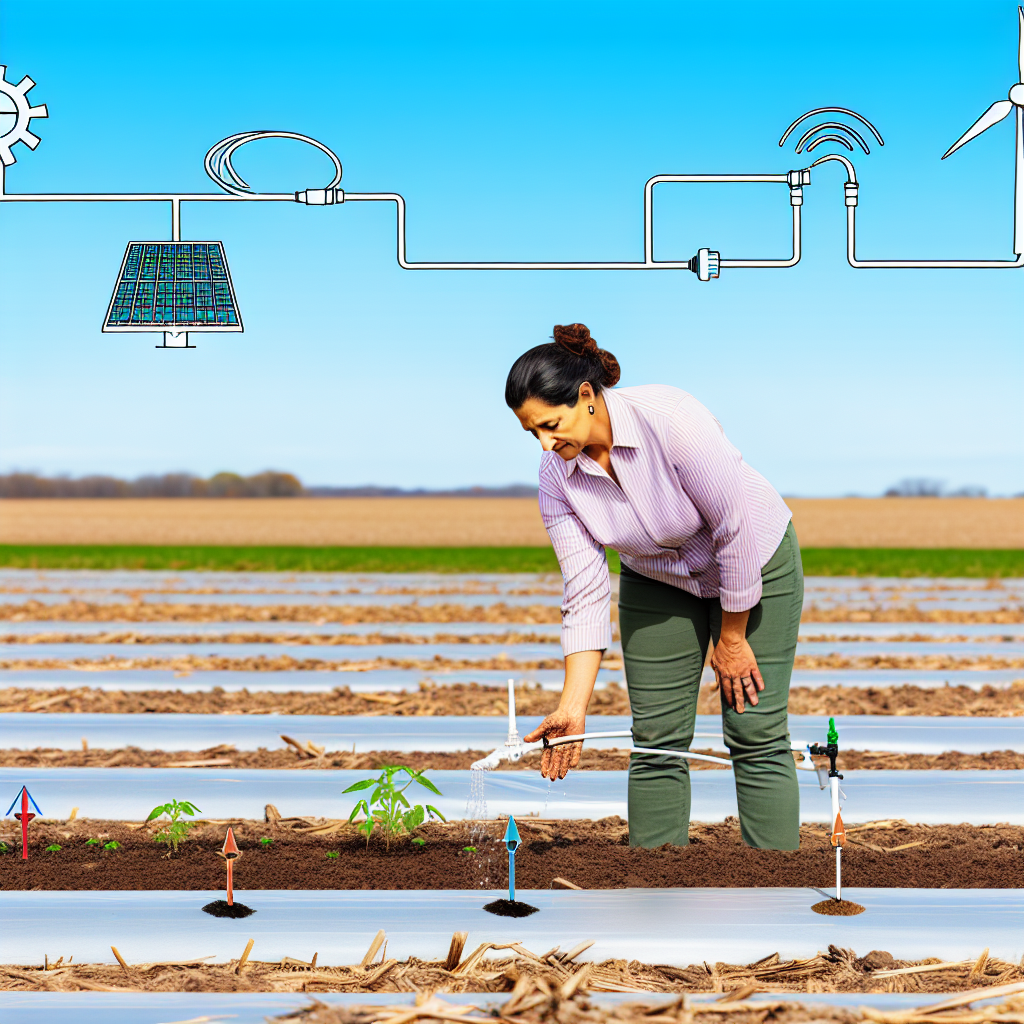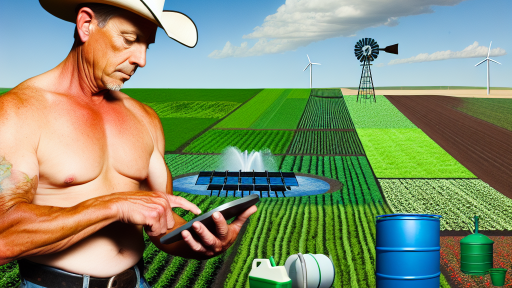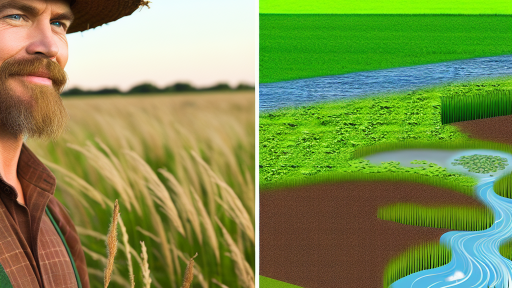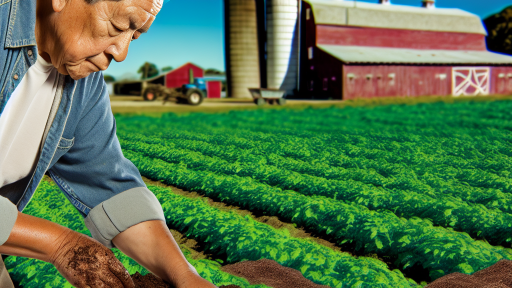Introduction to Climate Smart Farming
Definition and Importance
Climate smart farming involves practices that increase agricultural productivity sustainably.
It addresses the challenges posed by climate change effectively.
Implementing these techniques enhances food security and resilience.
Moreover, it reduces greenhouse gas emissions significantly.
Key Principles of Climate Smart Farming
The first principle focuses on sustainable intensification of farming systems.
This means increasing yields without harming the environment.
Next, climate smart farming builds resilience against climate variability.
This approach helps farmers adapt to unpredictable weather patterns.
Finally, it aims to reduce agriculture’s carbon footprint considerably.
Innovative Practices and Technologies
Farmers utilize various innovative techniques to implement climate smart practices.
These practices include agroforestry, which integrates trees into farming systems.
Additionally, precision agriculture optimizes inputs like water and fertilizers.
Furthermore, cover cropping prevents soil erosion and enhances soil health.
These technologies not only increase productivity but also promote sustainability.
Global Impact of Climate Smart Farming
The adoption of climate smart farming techniques is crucial on a global scale.
Transform Your Agribusiness
Unlock your farm's potential with expert advice tailored to your needs. Get actionable steps that drive real results.
Get StartedIt contributes to the overall goal of reducing global warming.
By improving farming practices, it alleviates poverty in vulnerable communities.
Moreover, it enhances biodiversity by promoting diverse cropping systems.
Thus, the broader impact on ecosystems is beneficial for the planet.
Current Trends in Climate Smart Farming Technologies
Adoption of Precision Agriculture
Precision agriculture uses technology to optimize field-level management.
This technology enhances productivity while reducing environmental impact.
Farmers utilize GPS and remote sensing for better crop monitoring.
Additionally, drones help in assessing crop health efficiently.
This trend leads to sustainable resource use and increased efficiency.
Integration of Renewable Energy Sources
Farmers increasingly adopt renewable energy systems in their operations.
Solar panels provide clean energy for irrigation and heating.
Wind turbines contribute significantly to powering farming equipment.
Moreover, bioenergy from agricultural waste reduces dependence on fossil fuels.
This integration lowers carbon emissions and supports sustainability.
Utilization of Climate-Resilient Crops
Breeding climate-resilient crops has gained traction recently.
These crops withstand extreme weather conditions more effectively.
Farmers can achieve higher yields despite changing climate patterns.
Additionally, these crops often require fewer inputs, reducing overall costs.
This method safeguards food security in the face of climate change.
Implementation of Innovative Irrigation Techniques
Modern irrigation methods conserve water while maximizing efficiency.
Drip irrigation systems minimize water waste significantly.
Furthermore, soil moisture sensors help in precise water application.
This technology leads to healthier crops and optimal resource management.
Consequently, farmers are better equipped to deal with drought conditions.
Showcase Your Farming Business
Publish your professional farming services profile on our blog for a one-time fee of $200 and reach a dedicated audience of farmers and agribusiness owners.
Publish Your ProfileAdvancements in Soil Health Management
Healthy soil is crucial for sustainable farming practices.
Farmers adopt cover cropping to enhance soil fertility and structure.
Additionally, reduced tillage minimizes soil erosion and degradation.
Soil health assessments enable informed decisions about amendments.
This focus on soil health improves agricultural resilience over time.
Financial Benefits of Investing in Climate Smart Farming Techniques
Increased Yields
Investing in climate smart techniques leads to higher crop yields.
This increase results from improved soil health and better water management.
Farmers can enjoy a more reliable production cycle year after year.
Furthermore, adaptive practices can enhance resilience to extreme weather.
Cost Savings
Climate smart farming often reduces overall operational costs.
Implementing efficient irrigation systems lowers water usage significantly.
Additionally, using organic fertilizers can cut chemical costs.
As farmers conserve resources, they also see a decrease in energy expenses.
Diversified Income Streams
These techniques open doors to new markets and products.
Farmers can produce organic or sustainably sourced goods.
These products often fetch premium prices, increasing profit margins.
Moreover, they can engage in carbon credit trading, further boosting income.
Access to Financial Incentives
Many governments and institutions support climate smart initiatives.
Farmers may receive grants or subsidies for implementing sustainable practices.
Access to these financial incentives increases investment potential.
Funding programs can cover the costs of new technologies and training.
Positive Brand Image
Adopting climate smart practices enhances a farm’s reputation.
Consumers increasingly seek environmentally responsible products.
A sustainable brand image can attract new customers and loyalty.
Sharing success stories can further elevate a farm’s profile in the community.
Long-Term Viability
Investing in climate smart farming ensures long-term agricultural viability.
Sustainable practices can preserve land and resources for future generations.
This focus on sustainability builds resilience against climate-related risks.
Ultimately, it fosters a healthier ecosystem for farming and communities alike.
Explore Further: Effective Flood Management Strategies for Farmers
Case Studies: Successful Implementation of Climate Smart Farming
Innovative Practices in Peru
A cooperative in Peru implemented climate smart farming techniques effectively.
They focused on agroforestry and crop rotation strategies.
This improved soil health and increased crop yields significantly.
Farmers reported a 30% increase in productivity after adopting these practices.
Water Management in Australia
In Australia, farmers faced severe drought conditions.
A new irrigation system helped address water scarcity effectively.
This system employs precision technology to optimize water use.
As a result, farmers reduced water consumption by 40%.
This sustainable technique enhanced crop resilience to climate change.
Regenerative Agriculture in the USA
Several farms in the USA adopted regenerative agriculture practices.
Showcase Your Farming Business
Publish your professional farming services profile on our blog for a one-time fee of $200 and reach a dedicated audience of farmers and agribusiness owners.
Publish Your ProfileThey focused on cover cropping and reduced tillage methods.
These practices improved soil carbon storage and enhanced biodiversity.
Farmers achieved a 25% reduction in fertilizer use over three years.
Community Involvement in Kenya
A community-led project in Kenya emphasized local engagement.
Farmers received training in sustainable agricultural practices.
They implemented intercropping and agroecological techniques.
Thus, food security improved alongside economic stability.
Moreover, this initiative boosted community resilience to climate impacts.
Technology Integration in India
In India, smallholder farmers utilized mobile technology for weather updates.
This information helped them plan planting and harvesting schedules.
Additionally, farmers accessed markets directly through applications.
This reduced wastage and improved their income by 20%.
Technological integration empowered farmers to make informed decisions.
See Related Content: Advanced Technologies in Agricultural Water Management
Government Policies and Incentives Supporting Climate Smart Farming
Introduction to Government Initiatives
Governments worldwide recognize the importance of sustainable agriculture.
They implement policies to promote climate smart farming techniques.
These initiatives aim to reduce environmental impacts while boosting productivity.
Types of Government Support
Financial incentives play a crucial role in motivating farmers.
Grants and subsidies assist farmers in adopting new technologies.
Low-interest loans facilitate investments in sustainable practices.
Tax breaks reward farmers who use eco-friendly farming methods.
Research and Development Funding
Investment in research enhances the development of climate smart techniques.
Government grants support agricultural innovation projects.
Collaboration with universities fosters knowledge sharing and technology transfer.
Moreover, funding for pilot projects demonstrates new practices’ feasibility.
Educational Programs and Training
Training programs educate farmers about sustainable practices.
Workshops and seminars provide hands-on learning experiences.
Extension services offer ongoing support and resources to farmers.
These programs build awareness about climate change impacts in agriculture.
Regulatory Frameworks
Regulatory measures ensure compliance with environmental standards.
Farmers must adhere to rules that promote sustainability.
These regulations help protect natural resources and ecosystems.
Incentives are often linked to adherence to these standards.
Partnerships and Collaborations
Public-private partnerships enhance the effectiveness of initiatives.
Collaborations between governments and NGOs promote community engagement.
Furthermore, businesses can support farmers through funding and resources.
Collectively, these partnerships amplify the reach of sustainable farming practices.
Gain More Insights: Climate Change And Agricultural Market Trends

Challenges and Risks Associated with Climate Smart Farming Investments
Understanding the Landscape
Investing in climate smart farming involves significant risks.
The agricultural landscape is changing rapidly due to climate change.
Showcase Your Farming Business
Publish your professional farming services profile on our blog for a one-time fee of $200 and reach a dedicated audience of farmers and agribusiness owners.
Publish Your ProfileFarmers face increasing weather variability and extreme conditions.
This variability directly affects crop yields and profitability.
Financial Barriers to Entry
Access to capital remains a major challenge for farmers.
Many traditional lenders are hesitant to finance innovative technologies.
This reluctance stems from perceived risks associated with new methods.
Moreover, investors may require higher returns on climate tech investments.
Technological Adoption Risks
Adoption of new technologies involves inherent risks for farmers.
Learning curves can be steep, creating potential for initial failures.
Farmers must consider the costs of training and implementation.
Moreover, technology compatibility with existing farm operations can be problematic.
Market Uncertainty
Market conditions can significantly impact climate smart investments.
For instance, fluctuating commodity prices pose a threat to profitability.
Additionally, consumer preferences can shift unexpectedly at any time.
These shifts may lead to financial instability for farmers adopting new practices.
Regulatory Challenges
Farmers must navigate complex regulatory environments.
Different regions have varying regulations on farming practices.
Compliance with these regulations can create additional costs and delays.
Furthermore, changing policies can add layers of uncertainty to investments.
Long-term Viability Concerns
Investors worry about the long-term viability of climate smart technologies.
Proof of concept is crucial to attracting ongoing financial support.
Farmers need data showcasing the effectiveness of these methods.
Without robust evidence, sustaining investments may prove difficult.
Environmental Risks
Unforeseen environmental impacts pose risks to climate smart farming.
For example, new techniques may unintentionally harm local ecosystems.
Sustainability should always remain a primary focus in these investments.
Farmers bear the responsibility of ensuring environmental stewardship.
Discover More: Climate-Resilient Farming Practices to Save Water
Future Innovations in Climate Smart Farming Technology
Emerging Technologies in Agriculture
Innovations are transforming agriculture into a more sustainable industry.
Robotics plays a crucial role by automating routine farming tasks.
These robots can plant, weed, and harvest crops efficiently.
Moreover, drones provide valuable aerial insights for crop monitoring.
They help farmers assess crop health and resource needs effectively.
Additionally, precision agriculture utilizes data analytics for better decision-making.
This technology minimizes waste and maximizes resource use.
Advancements in Soil Management
Soil health remains vital for sustainable farming practices.
Innovations like biochar improve soil quality and carbon sequestration.
They enhance nutrient retention and reduce the need for chemical fertilizers.
Moreover, cover cropping prevents soil erosion and enhances biodiversity.
This method promotes healthy ecosystems that support agriculture.
Smart Irrigation Systems
Water management technology has seen significant improvements.
Showcase Your Farming Business
Publish your professional farming services profile on our blog for a one-time fee of $200 and reach a dedicated audience of farmers and agribusiness owners.
Publish Your ProfileDrip irrigation systems deliver water directly to plant roots.
This method conserves water and boosts crop yield substantially.
Smart sensors monitor soil moisture levels in real time.
Farmers receive alerts to optimize their irrigation schedules.
Climate-Resilient Crop Varieties
Research continues on developing climate-resilient crop varieties.
These crops withstand extreme weather conditions exceptionally well.
They help ensure food security in the face of climate change.
Genetic engineering and traditional breeding techniques play vital roles.
Farmers adopting these crops benefit from higher yields over time.
Role of Community and Collaboration
Community involvement fosters knowledge sharing among farmers.
Collaborating with agricultural researchers enhances information flow.
Farmers learn about the latest innovations and best practices easily.
Additionally, regional cooperation strengthens sustainable practices.
This approach promotes resilience against climate-related challenges.
Strategies for Farmers: How to Transition to Climate Smart Practices
Assessing Current Practices
Farmers need to evaluate their existing methods carefully.
This assessment helps identify areas needing improvement.
Next, they should understand the environmental impact of their practices.
Collecting data on water usage and soil health is essential.
Finally, farmers can measure their carbon footprint for better insights.
Investing in Sustainable Technologies
Farmers should consider upgrading to modern farming technologies.
Integrating precision agriculture can dramatically boost efficiency.
Moreover, utilizing solar powered equipment reduces reliance on fossil fuels.
Investing in drip irrigation systems can conserve water significantly.
Advanced soil sensors will help monitor and maintain soil health.
Implementing Crop Rotation and Diversity
Crop rotation introduces a natural pest management strategy.
This technique helps break cycles of pests and diseases.
Additionally, diversifying crops increases resilience to climate shocks.
Farmers can select drought-resistant and climate-friendly varieties.
Ultimately, mixed cropping systems enhance soil fertility over time.
Enhancing Community Engagement
Farmers must engage with local communities and organizations.
Participating in workshops can provide valuable knowledge and support.
Collaborating with local governments fosters better policy development.
Additionally, joining community-supported agriculture strengthens market ties.
Such networks can also share risks associated with climate change.
Monitoring and Adapting to Changes
A continuous monitoring system should be established on farms.
This will allow farmers to adapt practices as needed.
Farmers should invest time in learning about climate trends.
Using data analytics can enhance decision-making processes.
Feedback loops from monitored data will support ongoing improvements.
Additional Resources
Partnerships for Climate-Smart Commodities Helps Partners Expand …
Showcase Your Farming Business
Publish your professional farming services profile on our blog for a one-time fee of $200 and reach a dedicated audience of farmers and agribusiness owners.
Publish Your ProfileClimate-Smart Agriculture and Forestry Resources | Farmers.gov




